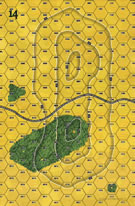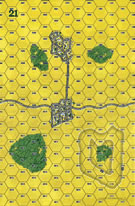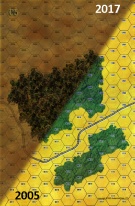|
Spearhead Iron Curtain #2 |
||
|---|---|---|
| (Attacker) United States | vs | Soviet Union (Defender) |
| Formations Involved | ||
|---|---|---|
| Soviet Union |  |
9th "Bobriusko-Berlinskaya" Tank Division |
| United States |  |
3rd "Spearhead" Armored Division |

|
| Overall Rating, 2 votes |
|---|
|
3
|
| Scenario Rank: --- of 964 |
| Parent Game | Iron Curtain |
|---|---|
| Historicity | Alt-History |
| Date | 1948-06-24 |
| Start Time | 06:00 |
| Turn Count | 30 |
| Visibility | Day |
| Counters | 165 |
| Net Morale | 0 |
| Net Initiative | 1 |
| Maps | 4: 14, 18, 21, 6 |
| Layout Dimensions | 112 x 43 cm 44 x 17 in |
| Play Bounty | 181 |
| AAR Bounty | 167 |
| Total Plays | 2 |
| Total AARs | 1 |
| Duplicates | HaSi022 |
| Battle Types |
|---|
| Exit the Battle Area |
| Conditions |
|---|
| Off-board Artillery |
| Smoke |
| Scenario Requirements & Playability | |
|---|---|
| Battle of the Bulge | Counters |
| Eastern Front | Maps + Counters |
| Iron Curtain | Base Game |
| Road to Berlin | Maps + Counters |
| Introduction |
|---|
|
On 24 June 1948, Soviet troops blocked road access between the Western-occupied sectors of Germany and the jointly occupied capital of Berlin. American, British and French troops in Berlin needed food and other supplies, as did the civilian populace in their zones. U.S. Army Gen. Lucius D. Clay suggested sending a large armored column down one of the highways toward Berlin, to "see if anyone will fire at them." |
| Conclusion |
|---|
|
President Truman declined Clay's suggestion, which would have been very difficult to execute in any event: most U.S. forces in Germany had been converted to "Constabulary" status, with only parts of the 1st Infantry Division conducting combat exercises. Combat divisions began to be re-activated in 1947, but the Spearhead division would not actually transition from a training unit to combat status until 1955. |
| AFV Rules Pertaining to this Scenario's Order of Battle |
|---|
|
| 2 Errata Items | |
|---|---|

|
All Guards JS-IIs should have AT fire values of 8-8. (Shad
on 2010 Dec 15)
|

|
All Guards T-34/85 tanks should have AT fire values of 7-7. (Shad
on 2010 Dec 15)
|
| Better Try an Airlift Next Time | ||||||||||||
|---|---|---|---|---|---|---|---|---|---|---|---|---|
First Play Setup: The Soviets setup their units pretty evenly across Boards 21, 6, and 14, with several units blocking the road to prevent the Americans from utilizing the road for their trucks. Play: The Americans enter on the South edge and occupy the limiting terrain on Board 18. Over the next 26 turns, the Americans move four trucks, evading the Soviet defenses, hoping the Soviet don't roll the 11 they need to begin firing at the Americans. The Soviets never roll above a 10, and the American trucks pass through to Berlin, without a single step loss on either side. Result: American Major Victory. Berlin is resupplied. Second Play Setup: Same as Play One. Play: The Americans advance under the cover of smoke over the first hour after the Soviets roll a 12 on turn three, releasing the two armies for combat. The Americans have limited success in the four town hexes, while quickly taking the hill in the west and the small woods in the east. After another hour of recovering and continued fighting in the town, the Soviets bring up reinforcements from Board 6 while the Americans begin to swarm with all their tanks, from the M4's to the the M26's, rolling towards the town. The American's advance begins well taking out a few of the JS-3's, but the remaining Soviet tanks shred the lightly armored American tanks. Meanwhile the American infantry move forward towards the second line of Soviet defense. The assaults in the second line go very well for the Soviets, and the Soviets repulse the American's attacks on either side of the main town on Board 21. After several turns of assaults, some recovered American infantry finally take the main town. However, with only four turns left the Soviets still hold two of the four Boards, and the Americans call for a general retreat. Result: Major Soviet Victory. The Americans fail to resupply Berlin. The Victory Point count stands at 98-130, with a 32 point lead for the Soviets. |
||||||||||||
| 0 Comments |

 IrCu001
IrCu001 





































